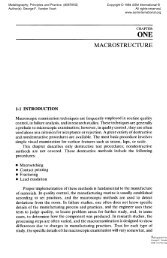A0004222_Titlepage 1..1 - ASM International
A0004222_Titlepage 1..1 - ASM International
A0004222_Titlepage 1..1 - ASM International
You also want an ePaper? Increase the reach of your titles
YUMPU automatically turns print PDFs into web optimized ePapers that Google loves.
© 2006 <strong>ASM</strong> <strong>International</strong>. All Rights Reserved.<br />
<strong>ASM</strong> Handbook, Volume 13C, Corrosion: Environments and Industries (#05145)<br />
Policy on Units of Measure<br />
By a resolution of its Board of Trustees, <strong>ASM</strong> <strong>International</strong> has adopted<br />
the practice of publishing data in both metric and customary U.S. units of<br />
measure. In preparing this Handbook, the editors have attempted to present<br />
data in metric units based primarily on Système <strong>International</strong> d’Unités (SI),<br />
with secondary mention of the corresponding values in customary U.S.<br />
units. The decision to use SI as the primary system of units was based on the<br />
aforementioned resolution of the Board of Trustees and the widespread use<br />
of metric units throughout the world.<br />
For the most part, numerical engineering data in the text and in tables are<br />
presented in SI-based units with the customary U.S. equivalents in parentheses<br />
(text) or adjoining columns (tables). For example, pressure, stress,<br />
and strength are shown both in SI units, which are pascals (Pa) with a<br />
suitable prefix, and in customary U.S. units, which are pounds per square<br />
inch (psi). To save space, large values of psi have been converted to kips<br />
per square inch (ksi), where 1 ksi=1000 psi. The metric tonne (kg · 10 3 )<br />
has sometimes been shown in megagrams (Mg). Some strictly scientific<br />
data are presented in SI units only.<br />
To clarify some illustrations, only one set of units is presented on artwork.<br />
References in the accompanying text to data in the illustrations are<br />
presented in both SI-based and customary U.S. units. On graphs and charts,<br />
grids corresponding to SI-based units usually appear along the left and<br />
bottom edges. Where appropriate, corresponding customary U.S. units<br />
appear along the top and right edges.<br />
Data pertaining to a specification published by a specification-writing<br />
group may be given in only the units used in that specification or in dual<br />
units, depending on the nature of the data. For example, the typical yield<br />
strength of steel sheet made to a specification written in customary U.S.<br />
iv<br />
www.asminternational.org<br />
units would be presented in dual units, but the sheet thickness specified in<br />
that specification might be presented only in inches.<br />
Data obtained according to standardized test methods for which the<br />
standard recommends a particular system of units are presented in the units<br />
of that system. Wherever feasible, equivalent units are also presented.<br />
Some statistical data may also be presented in only the original units used in<br />
the analysis.<br />
Conversions and rounding have been done in accordance with IEEE/<br />
ASTM SI-10, with attention given to the number of significant digits in the<br />
original data. For example, an annealing temperature of 1570 F contains<br />
three significant digits. In this case, the equivalent temperature would be<br />
given as 855 C; the exact conversion to 854.44 C would not be appropriate.<br />
For an invariant physical phenomenon that occurs at a precise<br />
temperature (such as the melting of pure silver), it would be appropriate to<br />
report the temperature as 961.93 C or 1763.5 F. In some instances<br />
(especially in tables and data compilations), temperature values in C and<br />
F are alternatives rather than conversions.<br />
The policy of units of measure in this Handbook contains several<br />
exceptions to strict conformance to IEEE/ASTM SI-10; in each instance,<br />
the exception has been made in an effort to improve the clarity of the<br />
Handbook. The most notable exception is the use of g/cm 3 rather than<br />
kg/m 3 as the unit of measure for density (mass per unit volume).<br />
SI practice requires that only one virgule (diagonal) appear in units<br />
formed by combination of several basic units. Therefore, all of the units<br />
preceding the virgule are in the numerator and all units following the<br />
virgule are in the denominator of the expression; no parentheses are<br />
required to prevent ambiguity.

















